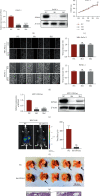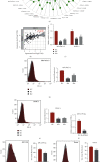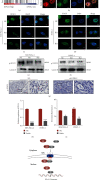Increased Nuclear Transporter KPNA2 Contributes to Tumor Immune Evasion by Enhancing PD-L1 Expression in PDAC
- PMID: 33728352
- PMCID: PMC7939744
- DOI: 10.1155/2021/6694392
Increased Nuclear Transporter KPNA2 Contributes to Tumor Immune Evasion by Enhancing PD-L1 Expression in PDAC
Abstract
Pancreatic ductal adenocarcinoma (PDAC) is one of the deadliest malignancies and is known for its high resistance and low response to treatment. Tumor immune evasion is a major stumbling block in designing effective anticancer therapeutic strategies. Karyopherin alpha 2 (KPNA2), a member of the nuclear transporter family, is elevated in multiple human cancers and accelerates carcinogenesis. However, the specific role of KPNA2 in PDAC remains unclear. In this study, we found that expression of KPNA2 was significantly upregulated in PDAC compared to adjacent nontumor tissue and its high expression was correlated with poor survival outcome by analyzing the GEO datasets. Similar KPNA2 expression pattern was also found in both human patient samples and KPC mouse models through IHC staining. Although KPNA2 knockdown failed to impair the vitality and migration ability of PDAC cells in vitro, the in vivo tumor growth was significantly impeded and the expression of immune checkpoint ligand PD-L1 was reduced by silencing KPNA2. Furthermore, we uncovered that KPNA2 modulated the expression of PD-L1 by mediating nuclear translocation of STAT3. Collectively, our data suggested that KPNA2 has the potential to serve as a promising biomarker for diagnosis in PDAC.
Copyright © 2021 Kai-Xia Zhou et al.
Conflict of interest statement
The authors declare that they have no conflict of interest.
Figures




Similar articles
-
The Moonlighting Function of Glutaminase 2 Promotes Immune Evasion of Pancreatic Ductal Adenocarcinoma by Tubulin Tyrosine Ligase-like 1-Mediated Yes1 Associated Transcriptional Regulator Glutamylation.Gastroenterology. 2025 Jun;168(6):1137-1152. doi: 10.1053/j.gastro.2025.01.240. Epub 2025 Feb 7. Gastroenterology. 2025. PMID: 39924055
-
Programmed cell death ligand 1 cut-point is associated with reduced disease specific survival in resected pancreatic ductal adenocarcinoma.BMC Cancer. 2017 Sep 5;17(1):618. doi: 10.1186/s12885-017-3634-5. BMC Cancer. 2017. PMID: 28870260 Free PMC article.
-
Programmed Cell Death Ligand-1 (PD-L1) and CD8 Expression Profiling Identify an Immunologic Subtype of Pancreatic Ductal Adenocarcinomas with Favorable Survival.Cancer Immunol Res. 2019 Jun;7(6):886-895. doi: 10.1158/2326-6066.CIR-18-0822. Epub 2019 May 1. Cancer Immunol Res. 2019. PMID: 31043417 Free PMC article.
-
The clinicopathological and prognostic significance of PD-L1 expression in pancreatic cancer: A meta-analysis.Hepatobiliary Pancreat Dis Int. 2018 Apr;17(2):95-100. doi: 10.1016/j.hbpd.2018.03.007. Epub 2018 Mar 13. Hepatobiliary Pancreat Dis Int. 2018. PMID: 29576277 Review.
-
The critical roles of activated stellate cells-mediated paracrine signaling, metabolism and onco-immunology in pancreatic ductal adenocarcinoma.Mol Cancer. 2018 Feb 19;17(1):62. doi: 10.1186/s12943-018-0815-z. Mol Cancer. 2018. PMID: 29458370 Free PMC article. Review.
Cited by
-
Histone H1.2 promotes hepatocarcinogenesis by regulating signal transducer and activator of transcription 3 signaling.Cancer Sci. 2022 May;113(5):1679-1692. doi: 10.1111/cas.15336. Epub 2022 Mar 30. Cancer Sci. 2022. PMID: 35294987 Free PMC article.
-
Increased Nuclear Transporter Importin 7 Contributes to the Tumor Growth and Correlates With CD8 T Cell Infiltration in Cervical Cancer.Front Cell Dev Biol. 2021 Sep 28;9:732786. doi: 10.3389/fcell.2021.732786. eCollection 2021. Front Cell Dev Biol. 2021. PMID: 34650978 Free PMC article.
-
Multiomics-based analyses of KPNA2 highlight its multiple potentials in hepatocellular carcinoma.PeerJ. 2021 Sep 21;9:e12197. doi: 10.7717/peerj.12197. eCollection 2021. PeerJ. 2021. PMID: 34616632 Free PMC article.
-
NS3 of hepatitis C virus drives hepatocellular carcinoma progression through a novel RNA-interference pathway.J Cell Commun Signal. 2025 Apr 12;19(2):e70013. doi: 10.1002/ccs3.70013. eCollection 2025 Jun. J Cell Commun Signal. 2025. PMID: 40226576 Free PMC article.
-
Kombo knife combined with sorafenib in liver cancer treatment: Efficacy and safety under immune function influence.World J Gastrointest Oncol. 2024 Jul 15;16(7):3118-3157. doi: 10.4251/wjgo.v16.i7.3118. World J Gastrointest Oncol. 2024. PMID: 39072171 Free PMC article.
References
MeSH terms
Substances
LinkOut - more resources
Full Text Sources
Other Literature Sources
Medical
Research Materials
Miscellaneous

